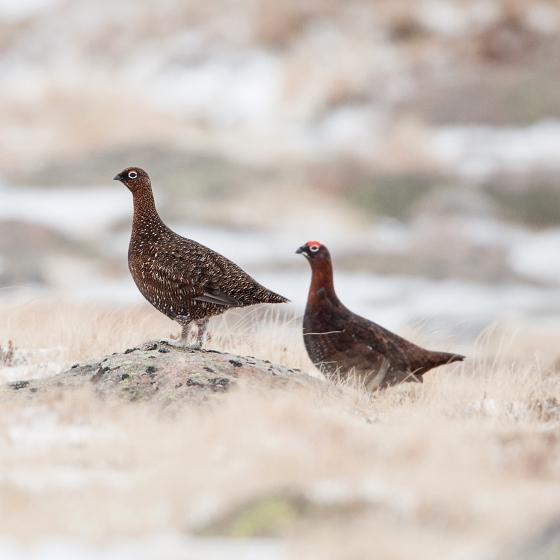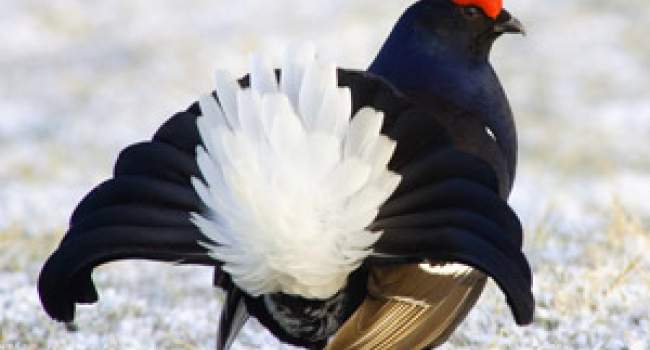Red Grouse
Lagopus lagopus (Linnaeus, 1758)
RG
 REDGR
REDGR  3290
3290

Family: Galliformes > Phasianidae

Red Grouse inhabit heather moorland and are often flushed from cover before being seen; as they depart on whirring wings they may call 'go back go back'.
The Red Grouse is a subspecies of Willow Ptarmigan, endemic to Britain and Ireland. Individuals retain their reddish-brown plumage all year round and the males are territorial during winter, during which time they form pairs. Eggs are laid in a vegetation-lined scrape from April and the resulting chicks develop fast and are capable of flight at just two weeks of age.
Breeding Bird Survey data show the Red Grouse population to be cyclical, with numbers apparently influenced by parasite presence. Reliant on heather, Red Grouse habitat and associated fauna are intensively managed to maintain Red Grouse numbers for shooting from the "glorious" 12th August.
Exploring the trends for Red Grouse
Our Trends Explorer will also give you the latest insight into how the UK's Red Grouse population is changing.
trends explorerIdentification
Red Grouse identification is usually straightforward. The following article may help when identifying Red Grouse.
Identifying Grouse

Grouse are classic birds of upland and wild habitats. Males are relatively easy to separate but females and distant birds can be much more difficult. Using plumage, habitat and habit clues we can tell them apart, however. Let this video help you confidently tell Red Grouse, Ptarmigan, Black Grouse and Capercaillie apart.
SONGS AND CALLS
Listen to example recordings of the main vocalisations of Red Grouse, provided by xeno-canto contributors.
Call
Song
Develop your bird ID skills with our training courses
Our interactive online courses are a great way to develop your bird identification skills, whether you're new to the hobby or a competent birder looking to hone your abilities.
Browse training coursesStatus and Trends
Population size and trends and patterns of distribution based on BTO surveys and atlases with data collected by BTO volunteers.
CONSERVATION STATUS
This species can be found on the following statutory and conservation listings and schedules.
POPULATION CHANGE
The distinctive dark-winged race scotica is endemic to Britain and Ireland and the vast bulk of its population occurs within the UK, thus conferring global significance to the UK trend. Recent research has even suggested that Irish birds may be another separate race hibernicus (McMahon et al. 2012), although this remains unclear. The Red Grouse is economically significant to some rural communities as a game bird and has benefited from intensive management of moorland (particularly in the east of the country) designed specifically to increase the numbers of grouse available to be shot. BBS shows fluctuations but no overall trend since 1994. Shooting bags have revealed long-term declines which prompted the move of the species from the green to the amber list in 2002. Following the 2015 review (Eaton et al. 2015), Red Grouse remains on the amber list as the species (as a whole) is considered 'Vulnerable' in a European context. Montane Fennoscandian populations also declined during 2002-12 (Lehikoinen et al. 2014), however it is no longer listed for population decline in the UK.
| UK breeding population |
No population change in UK (1995–2022) 
|
Exploring the trends for Red Grouse
Our Trends Explorer will also give you the latest insight into how the UK's Red Grouse population is changing.
trends explorerDISTRIBUTION
Red Grouse are characteristic of heather-dominated moorland in Britain and of raised and blanket bogs in Ireland. Being highly sedentary, the winter and breeding distribution maps are similar. Highest densities occur in the Pennines, North York Moors, Cheviot Hills, eastern Borders and the eastern Highlands of Scotland.
Occupied 10-km squares in UK
| No. occupied in breeding season | 878 |
| % occupied in breeding season | 29 |
| No. occupied in winter | 888 |
| % occupied in winter | 29 |
European Distribution Map
European Breeding Bird Atlas 2
Breeding Season Habitats
| Most frequent in |
Marsh 
|
Relative frequency by habitat
Relative occurrence in different habitat types during the breeding season.

DISTRIBUTION CHANGE
There have been widespread range contractions, including apparent extinction of the southwest England population.
Change in occupied 10-km squares in the UK
| % change in range in breeding season (1968–72 to 2008–11) | -25% |
| % change in range in winter (1981–84 to 2007–11) | +11.4% |
SEASONALITY
Red Grouse are recorded throughout the year, especially in spring when they are very vocal and easily detected.

Movement
Information about movement and migration based on online bird portals (e.g. BirdTrack), Ringing schemes and tracking studies.
RINGING RECOVERIES
View a summary of recoveries in the Online Ringing Report.
Biology
Lifecycle and body size information about Red Grouse, including statistics on nesting, eggs and lifespan based on BTO ringing and nest recording data.
PRODUCTIVITY & NESTING
Number of Broods 
|
1 |
Egg Size 
|
42×31 mm Weight = 21.5 g (of which 7% is shell) |
Exploring the trends for Red Grouse
Our Trends Explorer will also give you the latest insight into how the UK's Red Grouse population is changing.
trends explorerSURVIVAL & LONGEVITY
View number ringed each year in the Online Ringing Report
Typical Lifespan 
|
2 years with breeding typically at 1 year |
Adult Survival 
|
0.47  
|
Juvenile Survival 
|
0.34 (in first year) 
|
Exploring the trends for Red Grouse
Our Trends Explorer will also give you the latest insight into how the UK's Red Grouse population is changing.
trends explorerCODES & CLASSIFICATION
Ring size 
|
F* |
Field Codes 
|
2-letter: RG | 5-letter code: REDGR | Euring: 3290 |
For information in another language (where available) click on a linked name
Research
Interpretation and scientific publications about Red Grouse from BTO scientists.
CAUSES AND SOLUTIONS
Causes of change
Longer-term trends in Red Grouse abundance are overlain by cycles, with periods that vary regionally, linked to the dynamics of infection by a nematode parasite and to interrelated variations in the aggressiveness of males in autumn.
Further information on causes of change
Given its economic significance, long-term population trends of Red Grouse are likely to be closely associated with changes in management practices (see below). Shooting bags have revealed long-term declines, apparently driven by a combination of a loss of heather moorland, increased predation from corvids and foxes, and an increasing incidence of viral disease (Hudson 1992, Newton 2004). However, these trends appear to be overlain by cycles, with periods that vary regionally, linked to the dynamics of infection by a nematode parasite Trichostrongylus tenuis (Dobson & Hudson 1992, Gibbons et al. 1993) and to interrelated variations in the aggressiveness of males in autumn (Martinez-Padilla et al. 2014). Recent increases in the Red Grouse population have been attributed to the use of higher strengths of medicated grit (Thompson et al. 2016).
Strip burning of heather is undertaken to increase suitable habitat for Red Grouse. Although the short-term effect is to reduce the abundance of birds using the recently burnt areas (Douglas et al. 2017), densities subsequently increase most in areas where heather recovery is greatest (Ludwig et al. 2018c).
Analysis of game bag data since 1890 linked population changes to changes in keeper density and afforestation (Robertson et al. 2017). However the wider environmental impacts of moorland management for grouse are contested (Thompson et al. 2016, Sotherton et al. 2017). Whilst long-term declines are most likely linked to habitat changes (Thirgood et al. 2000), raptor predation may subsequently have limited population growth at some sites (Thirgood et al. 2000, Roos et al. 2018). In a study looking at four upland areas in the UK, higher Red Grouse abundance was correlated positively with higher predator control (Buchanan et al. 2017), and abundance and breeding success was higher at a Scottish site in years when predators were controlled (Ludwig et al. 2017). Other studies have concluded that mortality associated with raptors are important factors in survival but could not exclude scavenging so may have over-estimated true predation (Ludwig et al. 2018b, Francksen et al. 2019).
Hen Harriers in particular can reduce grouse shooting bags, limit grouse populations and cause economic losses to moor owners, which has led to instances of illegal persecution (Thompson et al. 2009, 2016, Murgatroyd et al. 2019; see also Conservation Actions section, below).
Laying dates in the Scottish Highlands advanced by about ten days between 1992 and 2011, and were inversely correlated with pre-laying temperatures, but no overall effect of climate change on chick survival could be identified (Fletcher et al. 2013).
At Langholm Moor, Red Grouse productivity was lower, suggesting higher chick predation, in years with high vole abundance; the reasons for this were unclear but were believed to be more consistent with the hypothesis that 'apparent competition' was occurring between voles and grouse, rather than the 'alternative prey' hypothesis, i.e. that incidental grouse chick predation is higher when increased vole numbers attract more predators (Ludwig et al. 2020b).
Information about conservation actions
This species is Amber-listed in the UK due to its European status; however, the fluctuating BBS trend does not raise any alerts and so does not give cause for concern. The species benefits from intensive management of moorland, to increase numbers available to be shot, and therefore no specific additional conservation actions are currently required.
Some observers have questioned the legitimacy of grouse shooting if it is only viable when birds of prey are routinely killed (Thompson et al. 2009), whilst others contend that grouse shooting protects the conservation of heather moorland and hence populations of some declining birds such as waders that depend upon it (Sotherton et al. 2009). The relative importance of predation and habitat management on numbers of Red Grouse, and on the wider environment including other moorland birds, in particular Hen Harrier, is the source of much debate with strongly opposing views (Redpath & Thirgood 2008, Thompson et al. 2016, Sotherton et al. 2017, Hodgson et al. 2018, 2019, St John et al. 2018). This has consequences for wider moorland management and the bird populations that live there (Redpath & Thirgood 2009, Thompson et al. 2016). The final report of the Langholm Moor Demonstration project concluded that whilst some targets had been met, the project was unable to achieve compatibility for management between raptor and Red Grouse interests and grouse numbers remained insufficient to make driven shooting viable (LMDP Partners 2019).
Links to more studies from ConservationEvidence.com
- Some characteristics of heath fires in north-east Scotland
- Effects of late summer cattle-grazing on the diversity of upland pasture vegetation in an upland conifer forest in Strathrory Glen, Easter Ross, Scotland
- Regeneration of heather (Calluna vulgaris (L.) Hull) at different ages and seasons in north-east Scotland
Read more studies about Red Grouse on Conservation Evidence >
Would you like to search for another species?











Share this page